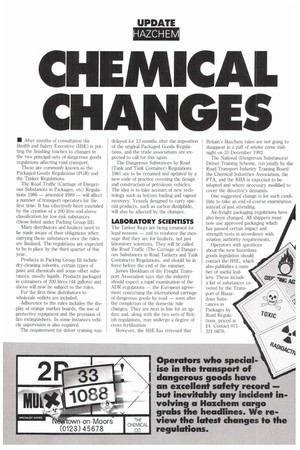CHEMICAL CHANGES
Page 26

If you've noticed an error in this article please click here to report it so we can fix it.
• After months of consultation the Health and Safety Executive (HSE) is putting the finishing touches to changes in the two principal sets of dangerous goods regulations affecting road transport.
These are commonly known as the Packaged Goods Regulations (PGR) and the Tanker Regulations.
The Road Traffic (Carriage of Dangerous Substances in Packages, etc) Regulations 1986 — amended 1989 — will affect a number of transport operators for the first time. It has effectively been extended by the creation of a 200-litre-and-above classification for low-risk substances (those listed under Packing Group HI).
Many distributors and hauliers need to be made aware of their obligations when carrying these substances once the rules are finalised. The regulations are expected to be in place by the third quarter of this year.
Products in Packing Group 111 include dry-cleaning solvents, certain types of paint and chemicals and some other substances, mostly liquids. Products packaged in containers of 200 litres (44 gallons) and above will now be subject to the rules.
For the first time distributors to wholesale outlets are included.
Adherence to the rules includes the display of orange marker boards, the use of protective equipment and the provision of fire extinguishers. In some instances vehicle supervision is also required.
The requirement for driver training was delayed for 12 months after the imposition of the original Packaged Goods Regulations, and the trade associations are expected to call for this again.
The Dangerous Substances by Road (Tank and Tank Container) Regulations 1981 are to be renamed and updated by a new code of practice covering the design and construction of petroleum vehicles. The idea is to take account of new technology such as bottom loading and vapour recovery. Vessels designed to carry special products, such as carbon disulphide, will also be affected by the changes.
LABORATORY SCIENTISTS
The Tanker Regs are being renamed for legal reasons — and to reinforce the message that they are for hauliers, not just laboratory scientists. They will be called the Road Traffic (The Carriage of Dangerous Substances in Road Tankers and Tank Containers) Regulations, and should be in force before the end of the summer.
James Hooldiam of the Freight Transport Association says that the industry should expect a rapid examination of the ADR regulations — the European agreement concerning the international carriage of dangerous goods by road — soon after the completion of the domestic rule changes. They are next in line for an update and, along with the two sets of British regulations, may undergo a degree of cross fertilisation.
However, the HSE has stressed that Britain's Hazchem rules are not going to disappear in a puff of smoke come midnight on 31 December 1992.
The National (Dangerous Substances) Driver Training Scheme, run jointly by the Road Transport Industry Training Board the Chemical Industries Association, the PTA, and the RHA is expected to be adopted and where necessary modified to cover the directive's demands.
One suggested change is for each candidate to take an end-of-course examination instead of just attending.
Air-freight packaging regulations have also been changed. All shippers must now use approved packaging which has passed certain impact and strength tests in accordance with aviation authority requirements.
Operators with questions about the new hazardous goods legislation should contact the HSE, which also publishes a number of useful leaflets. These include a list of substances covered by the Transport of Hazardous Substances in Packages by Road Regulations, priced at V. Contact 071221 0870,
































































